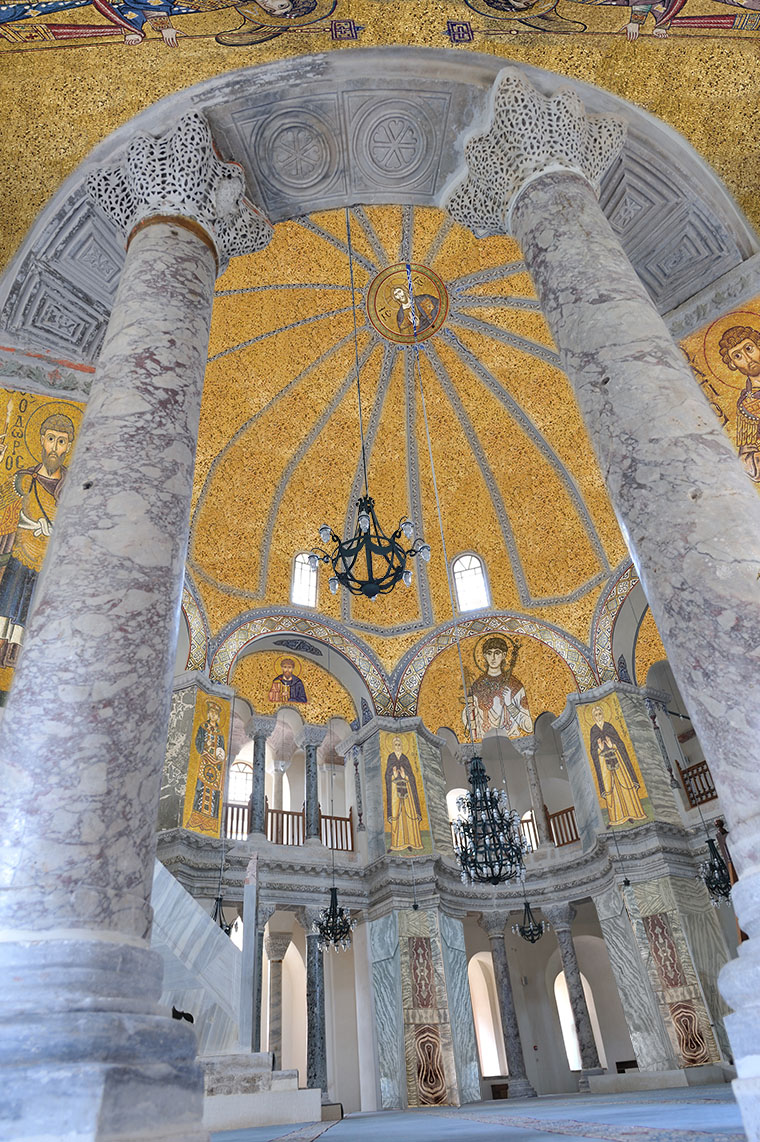
The poem inscribed on the cornice reads as follows:
Other emperors have honored the dead, Their labors were unrewarded. But
He who now holds our sceptres, pious Justinian
Honors with an illustrious house Sergius, servant
Of Christ, King of the universe, whom neither the flickering flame,
The sword, nor any other torture could hurt,
But who was constant unto death for Christ our God
And merits heaven by his blood. May he always Protect our ever-vigilant emperor
And augment the sway of Theodora, crowned by God;
She whose piety enlightens the soul; whose ceaseless Activity and unremitting good works bring
Relief to those who are crushed by poverty.
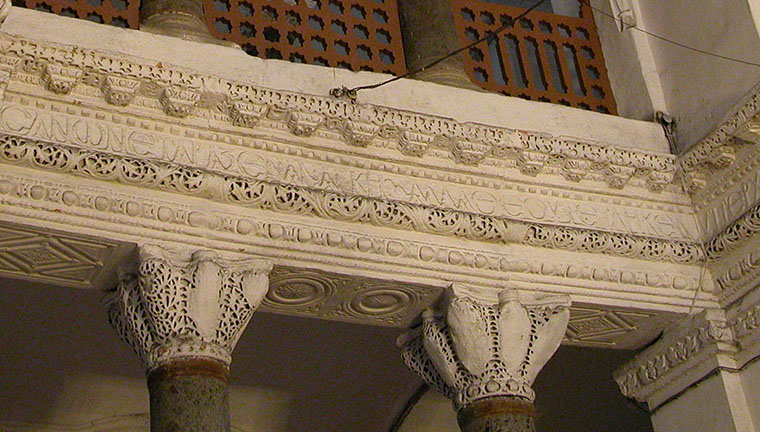 Above you can see the inscription carved into the lintel. The inscription survives because during Turkish times, when the church was a mosque, very few Turks could read Greek. The capitals have been damaged and crudely filled in with plaster.
Above you can see the inscription carved into the lintel. The inscription survives because during Turkish times, when the church was a mosque, very few Turks could read Greek. The capitals have been damaged and crudely filled in with plaster.
On the level tract beside the Sea of Marmora, to the south of the Hippodrome, stands the ancient octagon church of Sergius and Bacchus. It is now known as Kucuk Aya Sofia, Little Hagia Sophia, to denote at once its likeness and its unlikeness to the great church of that name. It can be reached by either of the two streets descending from the Hippodrome to the sea. In Byzantine times the church was a part of a complex of palaces and grand reception halls used by the Imperial court. There were also a bunch of churches nearby, none of which have survived. With the church of Sergius and Bacchus was associated a large monastery known, after the locality in which it stood, as the monastery of Hormisdas, ἐν τοῖς Ὁρμίσδου. It was richly endowed by Justinian.
Justinian, who built it, lived in the Hormisdas Palace - the location of the church - from 518-527. After he became emperor, Justinian and Theodora moved "up" to the Great Palace. The dedication of the church probably was in 530, the date of an important victory over Persia at Dara. The building took 2-3 years and the inscription could have been carved as early as 527. Besides the inscription the church is known for its elegant lacy sculpture which is deeply undercut creating deep shadows. Undercutting takes a lot of extra work for the sculptors. The pairs of columns, both below and above, are alternately Verd Antique and red Synnada marble, resting on bases of the blue-veined white Proconnesian marble from the island of Marmora. The capitals on the lower order are of the beautiful type known as the 'melon capital,' a form found also in San Vitale at Ravenna.
In the center of the capitals was carved the monogram of Justinian or that of Theodora. Most of the monograms have been effaced, but the name of the empress still appears on the capital of the western column in the south bay, while that of Justinian is found on the first capital in the south-western bay; on both capitals in the north-western bay, accompanied by the title Basileus; and, partially, on the last capital in the north-eastern bay. The columns, which are spanned by arches, on the second floor are smaller and have ionic capitals and impost blocks.
Sergius and Bacchus is tucked away near the sea wall and the remains of the Boukoleon Palace. It is easy to miss and very few tourists make it here. It's a shame because it is a delightful church, even in its current use as a mosque. It has been recently restored as an Ottoman mosque and is very pretty, well worth the effort of seeing it.
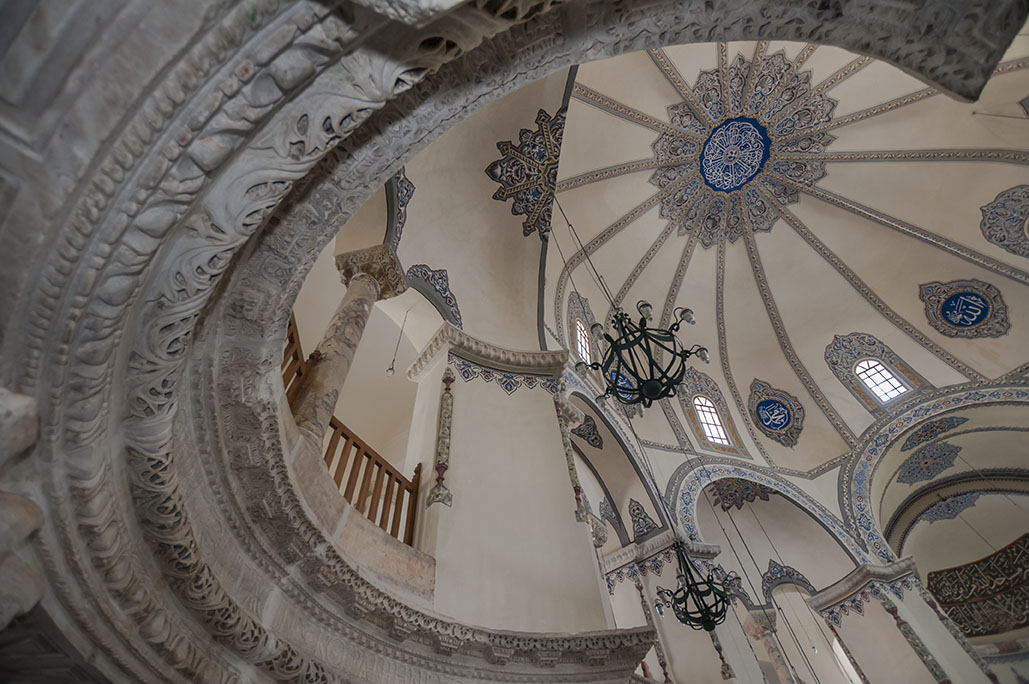 This church is remarkable for the survival of its amazing vaults, which are daring and innovative. The 50 ft. dome has no pendentives. Thus the architect and the builders were experienced in creation of flowing brick-faced masonry laid on wood forms that was removed after the mortar had dried. Such extravagant designs dared nature - think of how many earthquakes Constantinople experiences! And despite 1500 years of them the vaults of the church have survived. When they were decorated with fields of gold mosaic the vaults would have appeared to dissolve into heaven, sparkling and flashing.
This church is remarkable for the survival of its amazing vaults, which are daring and innovative. The 50 ft. dome has no pendentives. Thus the architect and the builders were experienced in creation of flowing brick-faced masonry laid on wood forms that was removed after the mortar had dried. Such extravagant designs dared nature - think of how many earthquakes Constantinople experiences! And despite 1500 years of them the vaults of the church have survived. When they were decorated with fields of gold mosaic the vaults would have appeared to dissolve into heaven, sparkling and flashing.
A chancel screen is indicated by the break off of the cornice inscription in the apse. Originally it ran straight across.
Besides a narthex-stoa, the church had an atrium and propylaea. which was shared with the adjoining Church of Peter and Paul. The space for Peter and Paul between Sergius and Bacchus and the sea wall is only 60 ft. so there was not much room for it. Procopius tells us it was a basilica with a columned gallery. Justinian's palace was to the east.
One of the major problems with the current presentation of the white and blue painted interior is this bright and pretty restoration has nothing to do with the Byzantine history of Sergius and Bacchus and only presents the Ottoman period.
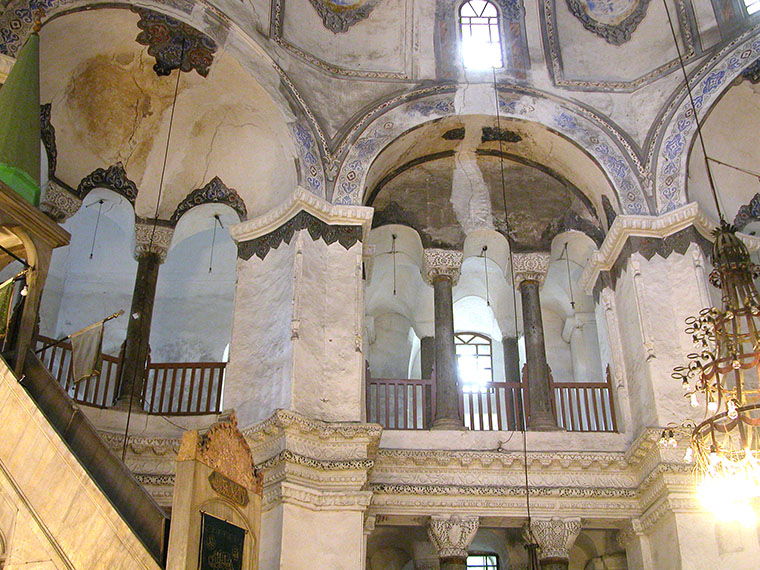
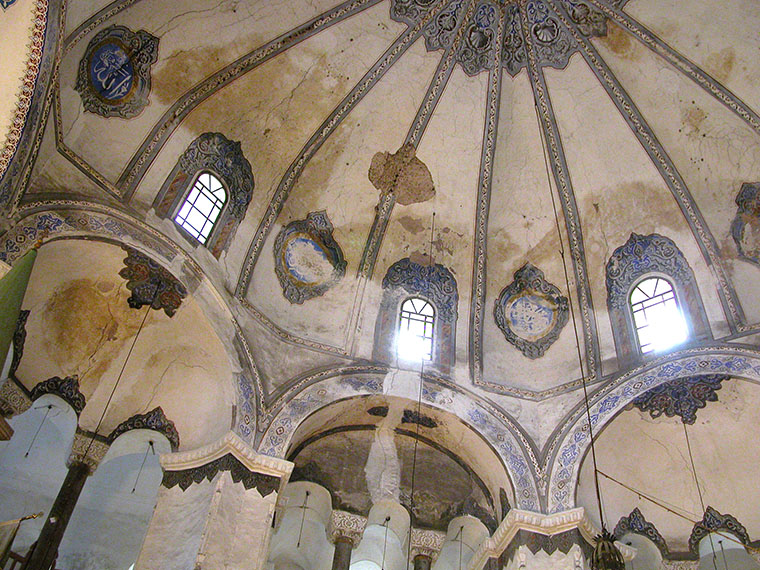
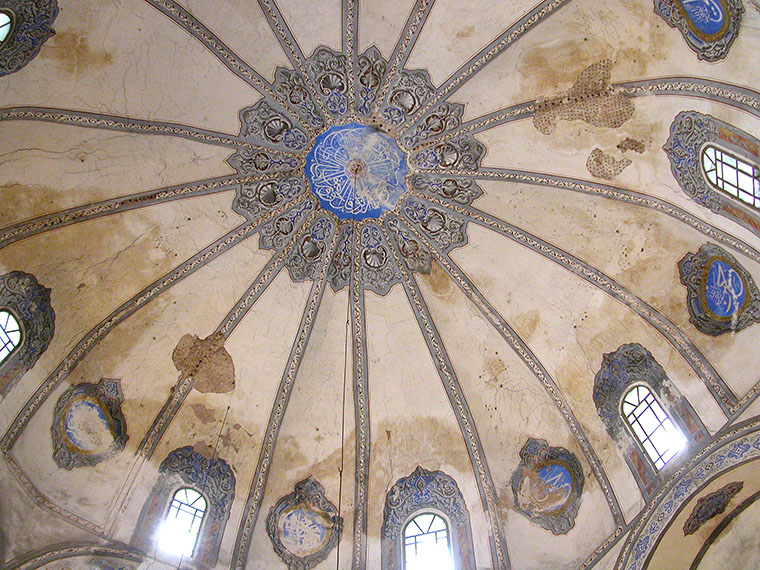 Above are three images which show the condition of Sergius and Bacchus in the late 1990s when it was near collapse. The situation was alarming, to say the least, and the church was only saved through international pressure and intervention.
Above are three images which show the condition of Sergius and Bacchus in the late 1990s when it was near collapse. The situation was alarming, to say the least, and the church was only saved through international pressure and intervention.
The inscription on the entablature of the lower colonnade in the church - seen above - proclaims the building to be a sanctuary erected by the Emperor Justinian and his Empress Theodora to the honor of the martyr Sergius. The building stands, moreover, as Sergius and Bacchus stood, close to the site of the palace and the harbor of Hormisdas.
Justinian needed as much help as he could get on the Eastern border with Persia. Being eastern saints with shrines in the danger zone Justinian hoped for their help in protecting the east. He built a series of fortresses along the border and this church should be seen as a spiritual link in the capital to that network. In addition, Justinian believed Sergius had intervened in a way that ensured he would get the throne when he had been in a tight spot.
No other building expresses the personal taste of Justinian and his actress wife Theodora as this one does. Justinian and Theodora were celebrities in their time who set the standard for sophistication in dress, personal style and interior decoration. As a former - and famous - actress Theodora knew what sophisticated fashion was - the popular colors, trends and lifestyle choices made by celebrities of the time. They lived in an extraordinary luxuriousness and splendor that was both admired and envied by Byzantine society. This youthful Imperial couple set the standard in everything they did. The design, spaciousness, color and grand intimacy of Saint Sergius and Bacchus - much more than Hagia Sophia - is the personal "style" statement of Justinian and Theodora.
It appears that the original mosaic decoration of the church was - like Hagia Sophia - non-figural. When Basil I restored images to the church he only mentions icons and furnishings for the liturgy being created and installed. The original icons had been effaced and removed by iconoclasts several times, the last being during the reign of Theophilos. Basil also did some work to secure the structure of the church. There had been a major earthquake on January 8, 869 which did extensive damage throughout Constantinople. Basil did a complete survey of the damage and ordered restoration wherever necessary, including work in Hagia Sophia and Holy Apostles. One of the advantages this church had was its location which was not plagued by fires. It was cut off from the rest of the city by the massive southern "fire-wall" of the Hippodrome.
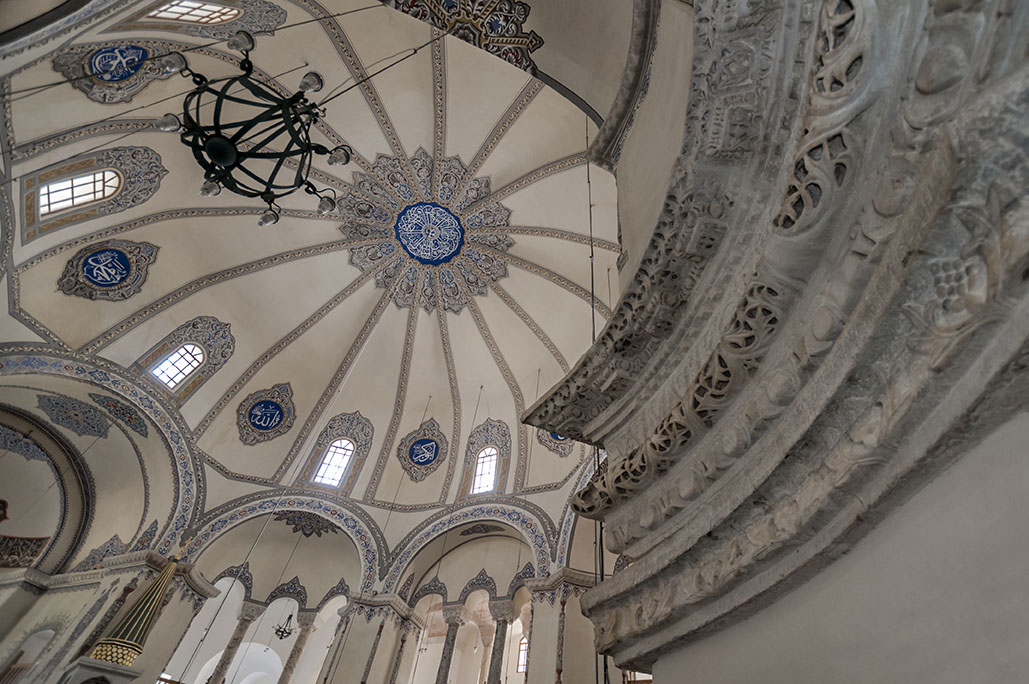 The walls were once covered in marble revetment, almost all of it has vanished. It was removed and used in other building projects after the Ottoman conquest. Most of the marble revetment in Hagia Sophia has also been removed and replaced with painted plaster.
The walls were once covered in marble revetment, almost all of it has vanished. It was removed and used in other building projects after the Ottoman conquest. Most of the marble revetment in Hagia Sophia has also been removed and replaced with painted plaster.
Before she became Justinian's wife Theodora lived in a world of famous sports stars dominated by figures like charioteers, boxers and wrestlers who were just as famous and rich then as now. Beautiful women - like Theodora - were the ornaments, trophies, of important male celebrities. One of the assets in a female consort to an important man was the ability to entertain and charm others. Theodora excelled at being a professional courtesan. Justinian really fell for her, it was a love match.
When Justinian ascended the throne in 527 Theodora became co-ruler, and participated in all aspects of Justinian's rule and authority - and had her own personal court. Sergius and Bacchus should been seen as an extension of Theodora's power in her own right. She entertained in the galleries above the nave that were attached to her personal quarters and hid her favorite Monophysite monks and bishops here.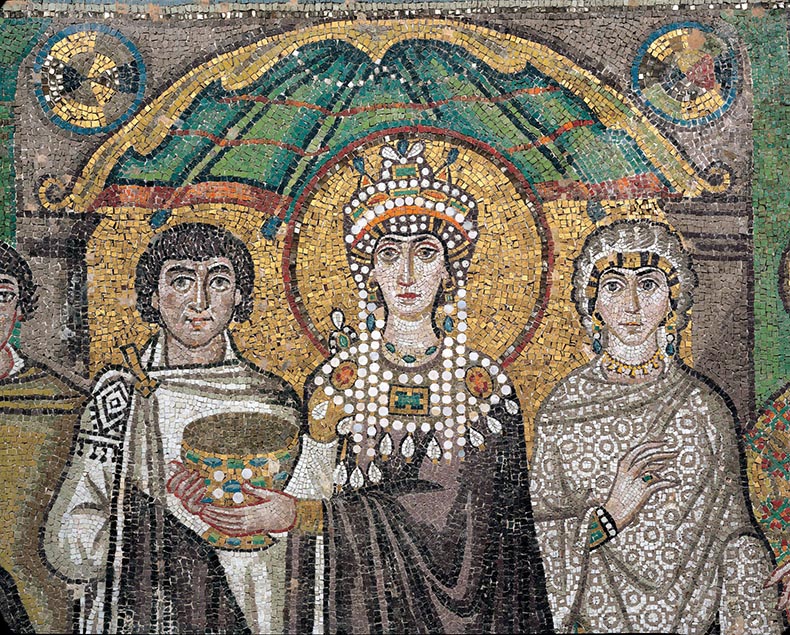
In spite of Justinian being Chalcedonian Christian, Theodora provided shelter in her palace for Monophysite leaders. A Monophysite Christian believes that in the person of Jesus Christ there is only one nature (wholly divine or only subordinately human), not two, as a Chalcedonian Christian does.
Anthimus, a Monophysite, had been appointed Patriarch of Constantinople under her influence, and after his excommunication he was hidden in Theodora's quarters for twelve years, until her death. When the Chalcedonian Patriarch Ephraim provoked a violent revolt in Antioch, eight Monophysite bishops were invited to Constantinople and Theodora welcomed them and housed them here in the Hormisdas Palace giving them this church to use in secret.
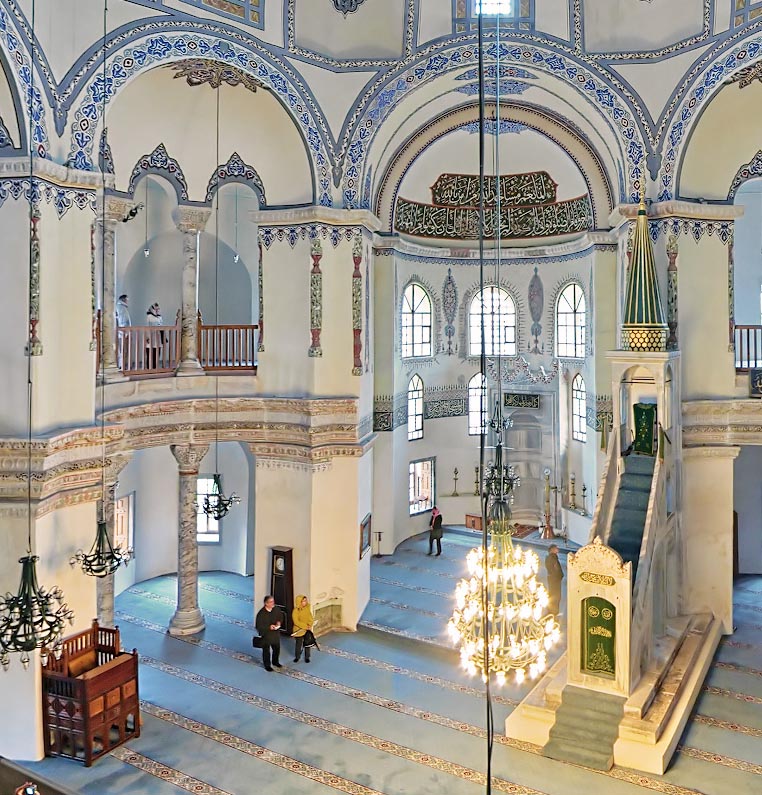
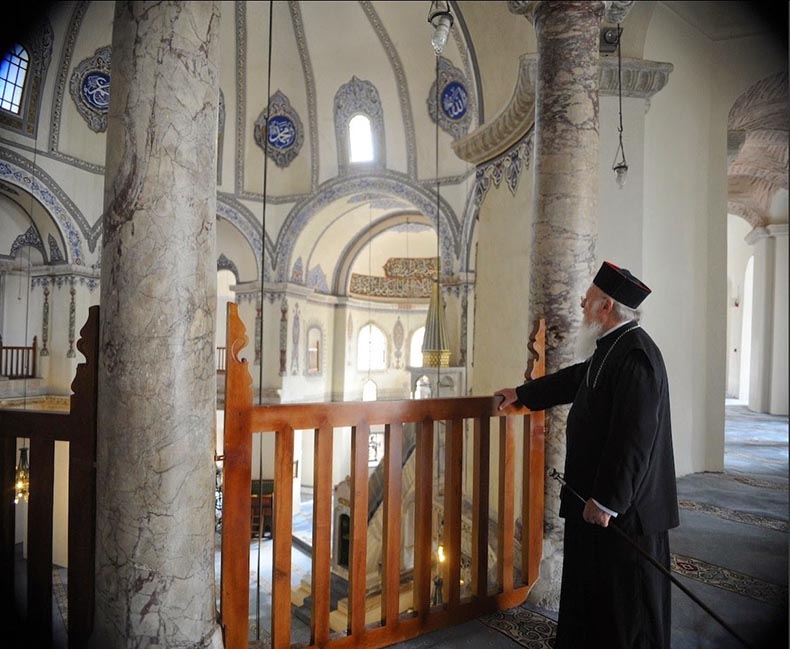
Above the Ecumenical Patriarch of the Orthodox church stands in the exact place where he would have during services when it was a church.
The church did not stand alone. Beside it and united with it, Justinian built also a church dedicated to the Apostles Peter (Peter was Justinian's baptismal name) and Paul, so that the two buildings formed a double sanctuary, having a common atrium and a continuous narthex. They were equal in size and in the richness of the materials employed in their construction, and together formed one of the chief ornaments of the palace and the city. There was, however, one striking difference between them; Sergius and Bacchus was a domical church, while Saints Peter and Paul was a basilica.
The saints to whom the church was dedicated were brother officers in the Roman army, who suffered death in the reign of Maximianus, and Justinian's particular veneration for them was due, it is said, to their interposition in his behalf at a critical moment in his career. Having been implicated, along with his uncle, afterwards Justin I, in a plot against the Emperor Anastasius, he lay under sentence of death for high treason; but on the eve of his execution, the saints Sergius and Bacchus, appeared to the Emperor in a vision and commanded him to spare the conspirators. Thus Justinian lived to reach the throne. In his devotion to Sergius and Bacchus he erected other sanctuaries to their honor around the Empire. Still this church, founded early in his reign, situated beside his residence while heir-apparent, and at the gates of the Great Palace, must be considered as Justinian's special thank offering for his crown. There is more about Sergius and Bacchus in the right column.
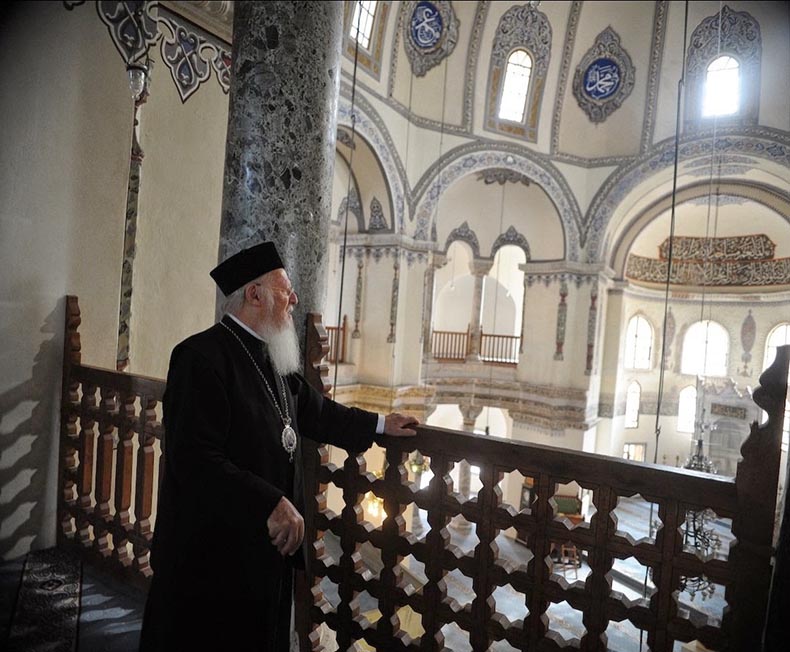 This picture above shows the scale of the building, which is vast, but still human. There are two significant things which have altered the interior, how it would have appeared in Byzantine times. The original floor was 3+ ft lower, the lower walls would have been sheathed in rare colored marbles, and the vaults would have been full of plain gold mosaic. The vast vaults of gold mosaic in such a brightly lit church would have magnified the light throughout the building, The polychrome, highly veined marble columns are almost entirely in light-colored stone, which also adds to the freshness and brightness of the church. I suspect the stones used were specifically chosen for this effect. Sergius and Bacchus can actually give us an idea of what many of the early halls and audience chambers of the 6th century Great Palace might have looked like.
This picture above shows the scale of the building, which is vast, but still human. There are two significant things which have altered the interior, how it would have appeared in Byzantine times. The original floor was 3+ ft lower, the lower walls would have been sheathed in rare colored marbles, and the vaults would have been full of plain gold mosaic. The vast vaults of gold mosaic in such a brightly lit church would have magnified the light throughout the building, The polychrome, highly veined marble columns are almost entirely in light-colored stone, which also adds to the freshness and brightness of the church. I suspect the stones used were specifically chosen for this effect. Sergius and Bacchus can actually give us an idea of what many of the early halls and audience chambers of the 6th century Great Palace might have looked like.
The glory and magnificence of the age of Justinian came to crashing halt when the Black Plague hit in 543, one-third to one-half of the population perished within a couple of months. It kept returning until 549. Justinian himself was badly infected, but survived. Rumors spread throughout the city that he had died. There were mass graves dug outside the walls of Constantinople filled with hundreds of thousands of corpses. Many bodies were left in piles within the city walls and others simply tossed into the sea. So many people died that tax revenues were drastically cut and Justinian had to halt new building projects and stop some that were underway. Having experienced so many years of gold following into his coffers he would not cut the people's taxes. Justinian was a cruel man, who found it impossible to feel empathy for his subjects, as a Christian emperor should. He drove himself even harder than he did his subjects and was haunted by his own internal demons. He traveled to famous shrines looking for relief for his sins without success. One of his last, when he was around 80 years old, was a trip to the shrine of the Archangel Michael in Germia.
The money Justinian gave to the monastery at Sergius and Bacchus must have ended suddenly with the plague. Many, if not most of the monks would have died, too.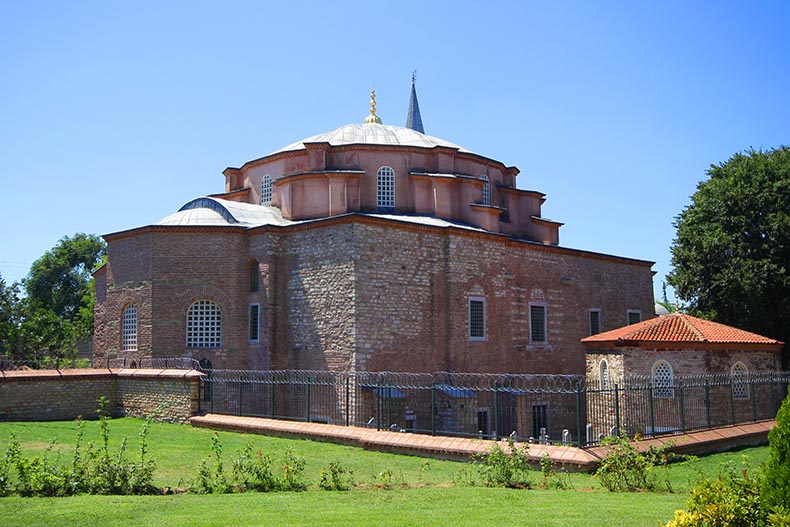 Here is a modern view of the church you can see how much the ground level has risen. When you enter the church you take more steps down.
Here is a modern view of the church you can see how much the ground level has risen. When you enter the church you take more steps down.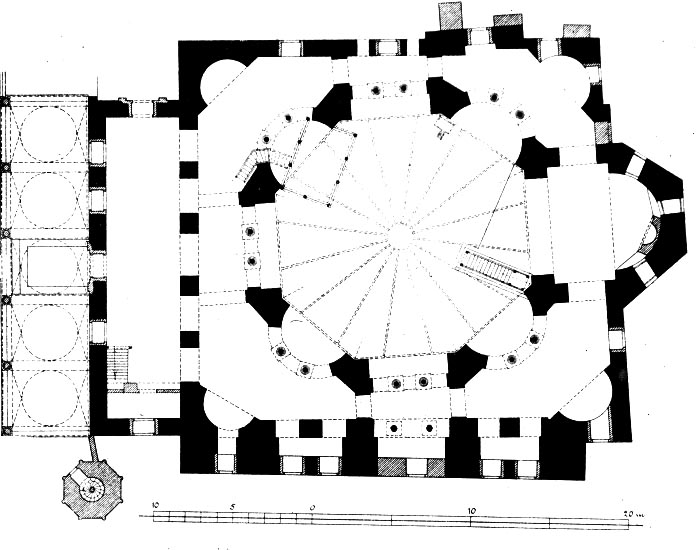 Here is a plan of the church. It looks off-center because it was built between two other buildings. On the south the original church opened onto the Church of Peter and Paul, which has vanished without a trace, leaving behind ghostly openings in the wall of the church, that have been filled in, which are easy to see.
Here is a plan of the church. It looks off-center because it was built between two other buildings. On the south the original church opened onto the Church of Peter and Paul, which has vanished without a trace, leaving behind ghostly openings in the wall of the church, that have been filled in, which are easy to see.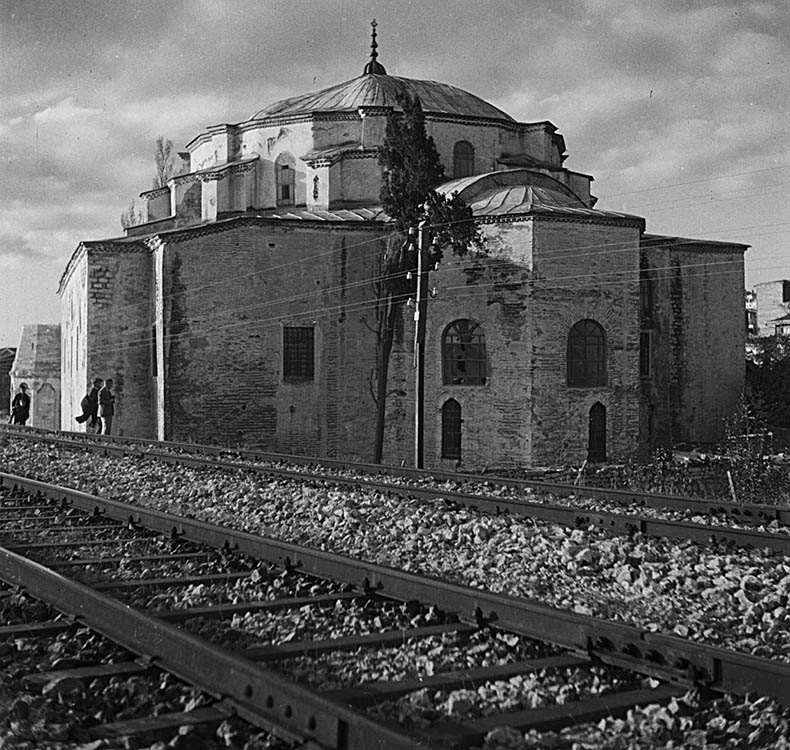 Travelers on the Orient Express would pass right by the church. All those years of heavy trains moving nearby did not bring down the vaults of the church. What a surprise. In 1877 it was reported that bricks and stones fell from the facade every time a train passed and that gaping holes were opening up in the wall. These train tracks went right through parts of the Boukoleon Palace, Great Palace and the Mangana. Building them destroyed the apse foundations of the Church of St. George of the Mangana.
Travelers on the Orient Express would pass right by the church. All those years of heavy trains moving nearby did not bring down the vaults of the church. What a surprise. In 1877 it was reported that bricks and stones fell from the facade every time a train passed and that gaping holes were opening up in the wall. These train tracks went right through parts of the Boukoleon Palace, Great Palace and the Mangana. Building them destroyed the apse foundations of the Church of St. George of the Mangana.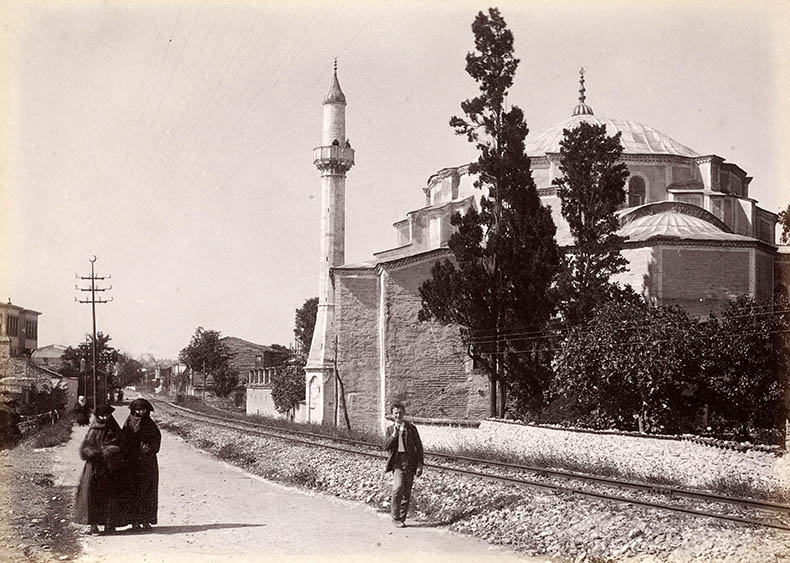 Another 19th century view of the train tracks
Another 19th century view of the train tracks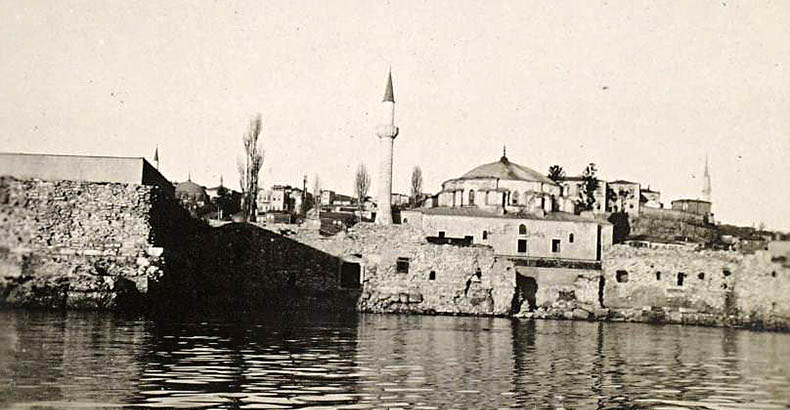 This is a very interesting 19th century view of the church as it would have been seen from the Sea of Marmora and how the dome could be seen over the sea walls. The Church of Peter and Paul filled the space between the church and the sea wall.
This is a very interesting 19th century view of the church as it would have been seen from the Sea of Marmora and how the dome could be seen over the sea walls. The Church of Peter and Paul filled the space between the church and the sea wall.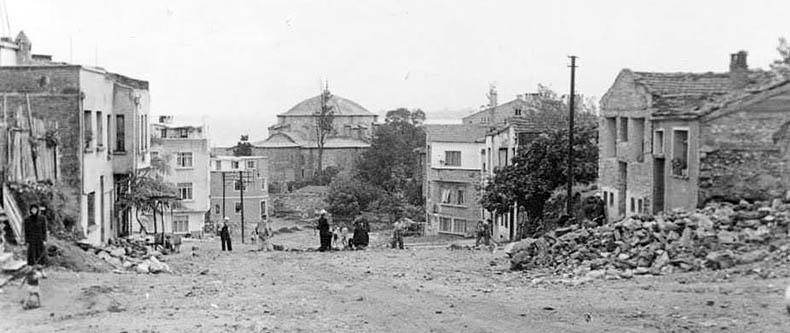 Here is another picture from the 19th century showing the area of the Great Palace. The openness gives you an idea of how the church might have looked when this area was more garden-like.
Here is another picture from the 19th century showing the area of the Great Palace. The openness gives you an idea of how the church might have looked when this area was more garden-like.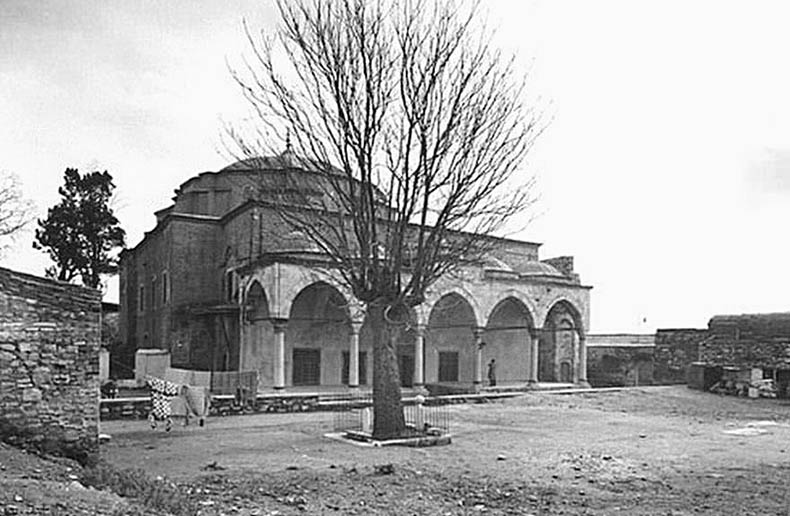 Here's a view from around 1900 showing a beautiful Turkish porch erected under Beyazit II (1481-1512). Originally there was a narthex stoa, an atrium and a great propylea - all shared with the Church of Peter and Paul. From here you take steps down into the church - maybe six feet lower. Saint Eirene is also deep in the earth now. Imagine what could be found if the plaza in front of the church was ever excavated. It would be full of remains of the churches and palaces that stood here. You can reach down into the dirt and pull up gold mosaic cubes and fragments of rare marbles.
Here's a view from around 1900 showing a beautiful Turkish porch erected under Beyazit II (1481-1512). Originally there was a narthex stoa, an atrium and a great propylea - all shared with the Church of Peter and Paul. From here you take steps down into the church - maybe six feet lower. Saint Eirene is also deep in the earth now. Imagine what could be found if the plaza in front of the church was ever excavated. It would be full of remains of the churches and palaces that stood here. You can reach down into the dirt and pull up gold mosaic cubes and fragments of rare marbles.



 This church is remarkable for the survival of its amazing vaults, which are daring and innovative. The 50 ft. dome has no pendentives. Thus the architect and the builders were experienced in creation of flowing brick-faced masonry laid on wood forms that was removed after the mortar had dried. Such extravagant designs dared nature - think of how many earthquakes Constantinople experiences! And despite 1500 years of them the vaults of the church have survived. When they were decorated with fields of gold mosaic the vaults would have appeared to dissolve into heaven, sparkling and flashing.
This church is remarkable for the survival of its amazing vaults, which are daring and innovative. The 50 ft. dome has no pendentives. Thus the architect and the builders were experienced in creation of flowing brick-faced masonry laid on wood forms that was removed after the mortar had dried. Such extravagant designs dared nature - think of how many earthquakes Constantinople experiences! And despite 1500 years of them the vaults of the church have survived. When they were decorated with fields of gold mosaic the vaults would have appeared to dissolve into heaven, sparkling and flashing.


 The walls were once covered in marble revetment, almost all of it has vanished. It was removed and used in other building projects after the Ottoman conquest. Most of the marble revetment in Hagia Sophia has also been removed and replaced with painted plaster.
The walls were once covered in marble revetment, almost all of it has vanished. It was removed and used in other building projects after the Ottoman conquest. Most of the marble revetment in Hagia Sophia has also been removed and replaced with painted plaster.












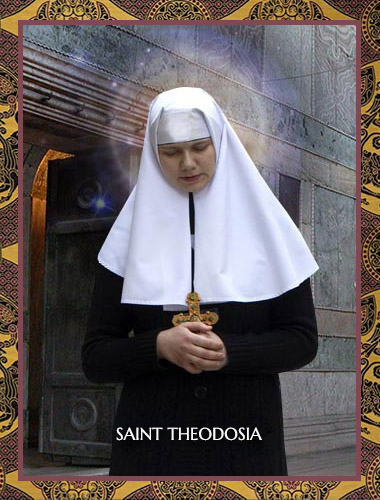

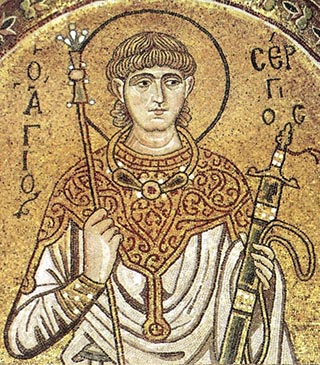
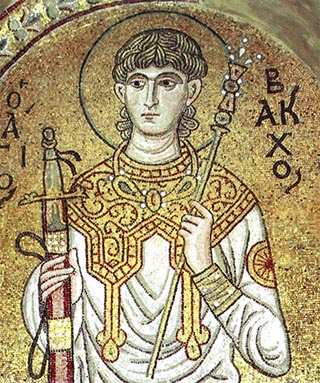
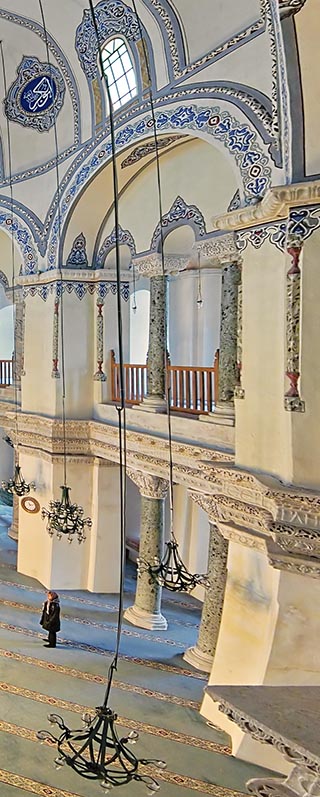
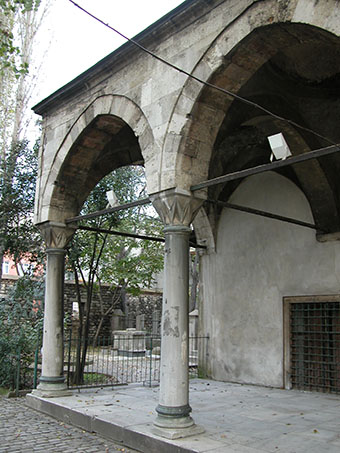
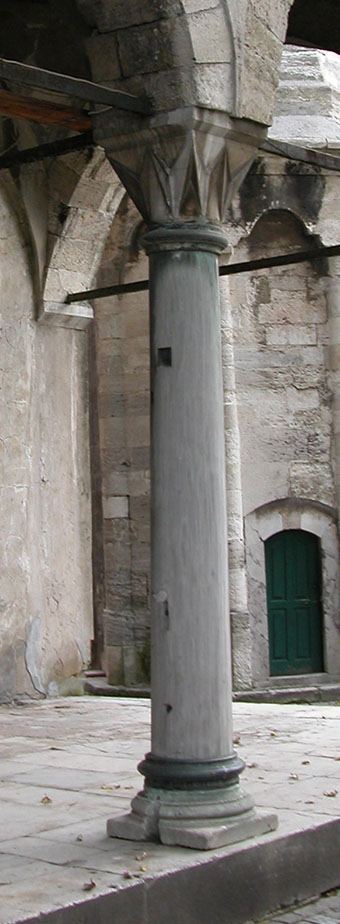
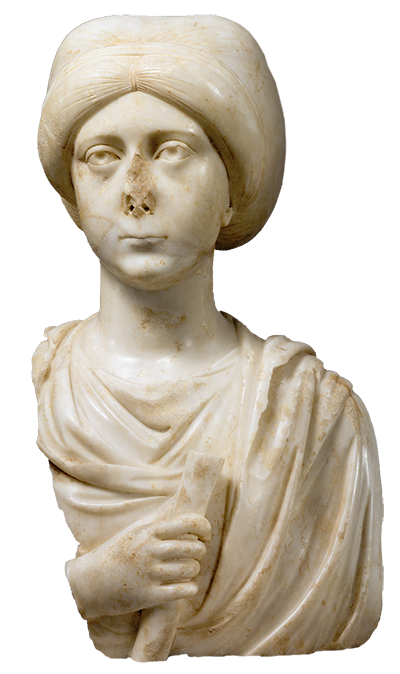
 click here for icons of christ
click here for icons of christ click here for icons of the theotokos
click here for icons of the theotokos click here for icons of angels
click here for icons of angels click here for icons of saints
click here for icons of saints








